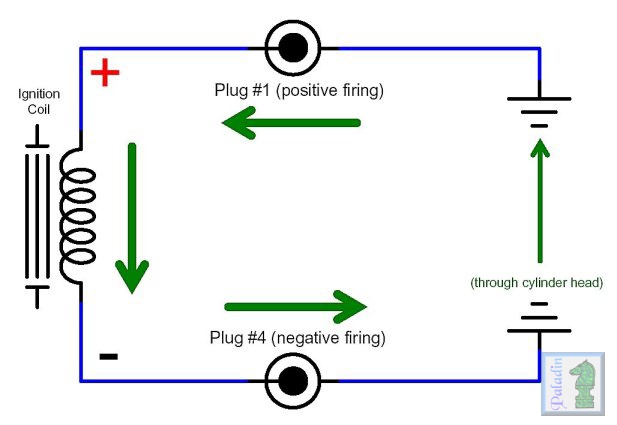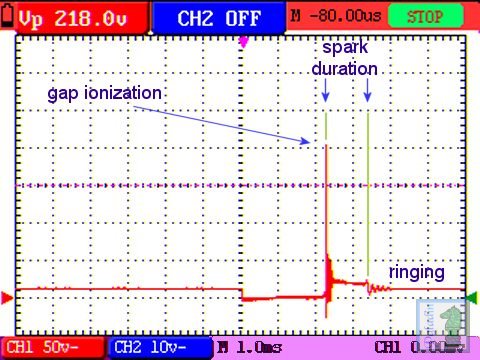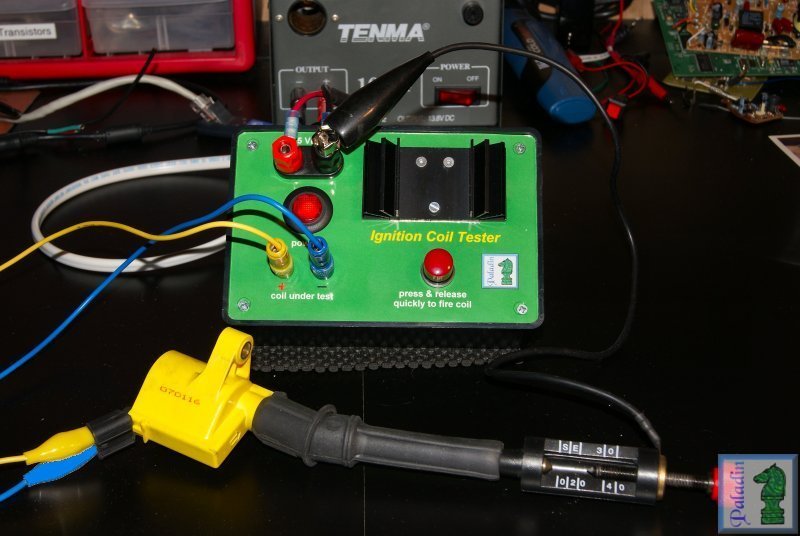- Cosmic_Jumper wrote:
- Thank you for addressing this issue, Cliff.
So then the idea here is that if you get a nice fat spark across that 10-12 mm gap the coil is okay. But if a marginal spark then increase the gap to 15mm at which point a deteriorated coil would be unabable to spark.
It seems to me that the ignition system fires both plugs at the same time? One cylinder at TDC while the opposite cylinder (piston), at 180°, is a BDC? If that's the case then only one spark plug wire needs to be used to determine whether the coil is the culprit. But if both plug wires are used individually for such a test then a deteriorated plug wire can be identified.
I had forgotten that the SWing was a single coil wasted spark system:

Were I using an air gap tester on such a system I would disconnect and ground t'other high tension lead to eliminate a bad plug from interfering with the coil test. Better yet would be disconnecting it (t'other ead) from the coil and grounding that coil post--making the system essentially a single coil/single plug configuration.
Or-use two air gaps, though they would both indicate pretty much the same thing.
The anatomy of a spark might be of interest:

The first "event" (from left to right) is the primary voltage drooping from +12V to ground as the ignitor pulls the coil's negative lead low (the equivalent of "points" closing), causing the coil's magnetic field to build--you can see to voltage at the + terminal rising as the coil charges (this is an inductive circuit).
After 2.2 ms or so the ignitor opens the ground connection (the "points" open) and the magnetic field collapses, generating a very high voltage,as much as 35 to 50 kV, in the coil's secondary windings until the plug gap ionises. This is reflected in the primary windings as the gap ionisation spike at some 200 V in the primary winding, 20 to 30 kV in the primary. Precious metal, fine wire electrode plugs, require much less voltage to ionise the gap, and thus fire more reliably and consistently than "fat wire" electrode plugs--especially worn fat wire plugs with eroded and rounded electrodes--though modern electronic ignition systems will continue to fire them, somewhat haphazardly and at the expense of coil life, well past their prime.
Once the "air" in the gap has been ionised to spark commences, lasting 1.0 ms or so in the trace. 50 V or so in the primary, 5000 to 6000 in the secondary. once the spark ends and remaining charge is resonantly dissipated, that is the "ringing" at the tail end of the event...
An ignition coil is just a transformer. At one time one coil, mechanically controlled by "points" supplied the "spark" for all cylinders, distributed by a thing oddly called a "distributor". On modern cars electronically controlled wasted spark and "coil-on-plug" (COP) system have eliminated distributors, points and condensors resulting in highly reliable ignition systems that can literally "blow the doors" off even the best racing system of 30 years ago.
Operated within their design parameters modern wasted spark coils and COPs will outlast whatever vehicle in which they are installed--Ford issue a TSB in 2005 or so alerting dealerships that 75% of the COPs being returned under warranty as defective had nothing wrong with them.
However running plugs past their prime, letting high tension wires (or the boots on COPS) deteriorate, and/or letting them get so dirty that cannot cool properly will burn them out. Heat is their greatest enemy, and if asked to do more than intended they will burn up.
I can burn 'em up with 25 to 30 full dump sparks across a 16 mm gap, that's why my COP Tester has been dubbed "
COP-Testo, the Destroyer"; 10 to 15 rapid dumps will make it so hot you cannot hold it in your hand, at 20 to 25 the magic smoke¹ starts coming out, by 30 they are toast:

----------------------------------------------------
¹- All modern electronic devices are filled with magic smoke at the time of manufacture. When that magic smoke comes out they are fubar, any attempts to repair are futile...
